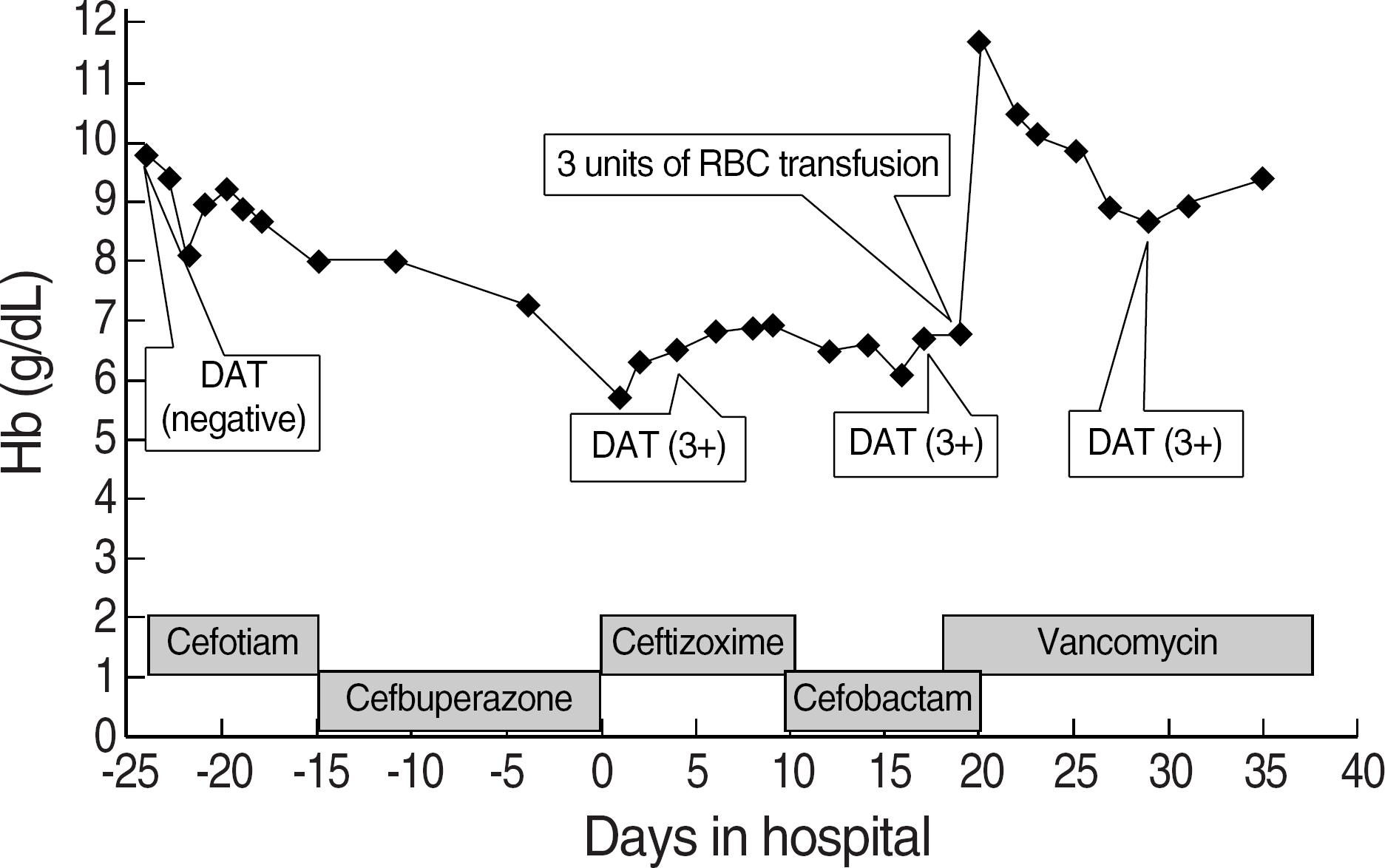Abstract
Simultaneous drug-induced immune hemolytic anemia (DIIHA) caused by multiple drugs is rare. We report a case of a patient who developed DIIHA caused by 2 drugs. The patient's serum exhibited agglutination of ceftizoxime- or sulbactam-coated red blood cells (RBCs; via a drug-adsorption mechanism) and of uncoated RBCs in the presence of sulbactam (via an immune-complex mechanism). Although ceftizoxime is known to exhibit a positive reaction by an immune-complex method with or without reactivity with drug-coated RBCs, this patient's antibodies were reactive only against drug-coated RBCs. On the other hand, sulbactam, which is known to cause hemolytic anemia by nonimmunologic protein adsorption, exhibited positive reactions in tests with both drug-coated RBCs and in the presence of sulbactam. This is the first report of DIIHA due to a sulbactam-cefoperazone combination and the fourth report of DIIHA due to ceftizoxime. Owing to the patient's complicated laboratory results, DIIHA was suspected only at a late stage. We propose that for the prompt diagnosis of DIIHA, tests for all possible causative drugs should be conducted by 2 methods.
REFERENCES
1.Ahrens N., Genth R., Kiesewetter H., Salama A. Misdiagnosis in patients with diclofenac-induced hemolysis: new cases and a concise review. Am J Hematol. 2006. 81:128–31.

2.Johnson ST., Fueger JT., Gottschall JL. One center's experience: the serology and drugs associated with drug-induced immune hemolytic anemia—a new paradigm. Transfusion. 2007. 47:697–702.

3.Arndt PA., Garratty G. The changing spectrum of drug-induced immune hemolytic anemia. Semin Hematol. 2005. 42:137–44.

4.Kim S., Song KS., Kim HO., Lee HM. Ceftriaxone induced immune hemolytic anemia: detection of drug-dependent antibody by ex-vivo antigen in urine. Yonsei Med J. 2002. 43:391–4.

5.Shammo JM., Calhoun B., Mauer AM., Hoffman PC., Baron JM., Baron BW. First two cases of immune hemolytic anemia associated with ceftizoxime. Transfusion. 1999. 39:838–44.

6.Calhoun BW., Junsanto T., Donoghue MT., Naureckas E., Baron JM., Baron BW. Ceftizoxime-induced hemolysis secondary to combined drug adsorption and immune-complex mechanisms. Transfusion. 2001. 41:893–7.

7.Endoh T., Yagihashi A., Sasaki M., Watanabe N. Ceftizoxime-induced hemolysis due to immune complexes: case report and determination of the epitope responsible for immune complex-mediated hemolysis. Transfusion. 1999. 39:306–9.

8.Broadberry RE., Farren TW., Bevin SV., Kohler JA., Yates S., Skidmore I, et al. Tazobactam-induced haemolytic anaemia, possibly caused by non-immunological adsorption of IgG onto patient's red cells. Transfus Med. 2004. 14:53–7.

9.Garratty G., Arndt PA. Positive direct antiglobulin tests and haemolytic anaemia following therapy with beta-lactamase inhibitor containing drugs may be associated with nonimmunologic adsorption of protein onto red blood cells. Br J Haematol. 1998. 100:777–83.

11.Drouillard DD. Transfusion therapy for autoimmune hemolytic anemia patients: a laboratory perspective. Clin Lab Sci. 2008. 21:7–11.
12.Roback JD, Combs MR, editors. Technical manual. 16th ed.Bethesda: American Association of Blood Banks;2008. p. 893–934.
Fig. 1.
Changes in the hemoglobin levels depending on the drugs administered and the days of hospitalization. The day the patient was admitted to our hospital was considered as hospitalization day 0.
Abbreviations: DAT, direct antiglobulin test; Cefobactam, cefoperazone/sulbactam.

Table 1.
Patient's laboratory results at the time of admission
| Test | Patient's results | Reference interval |
|---|---|---|
| Hematological values | ||
| Hemoglobin (g/dL) | 5.7 | 12.0-16.0 |
| Hematocrit (%) | 18.0 | 37.0-47.0 |
| RBC count (×106/μL) | 2.08 | 4.0-5.4 |
| Mean corpuscular volume (fL) | 91.1 | 80.0-98.0 |
| Mean corpuscular hemoglobin (pg) | 31.4 | 27.0-33.0 |
| MCHC (g/dL) | 34.5 | 33.0-37.0 |
| RDW (%) | 13.4 | 11.5-14.5 |
| Absolute reticulocyte count (×103/μL) | 86.6 | 20.8-109.6 |
| Reticulocyte proportion (%) | 4.8 | 0.5-2.31 |
| Total bilirubin (mg/dL) | 0.5 | 0.2-1.2 |
| Lactic dehydrogenase (IU/L) | 462 | 225-455 |
| Direct antiglobulin test∗ | Positive | Negative |
| Haptoglobin (mg/dL) | <7.81 | 30.0-200.0 |
Table 2.
Testing of drug-coated RBCs
| Drugs | Drug-coated RBCs + patient's serum | Drug-coated RBCs + normal AB serum | Uncoated RBCs + patient's serum |
|---|---|---|---|
| Ceftizoxime | 2+ | 0 | 0 |
| Cefobactam | 2+ | 0 | 0 |
| Sulbactam | 1+∗ | 0 | 0∗ |
| Cefoperazone | 0∗ | 0 | 0∗ |
| Cefotiam | 0 | 0 | 0 |
| Cefbuperazone | 0 | 0 | 0 |
Table 3.
Testing in the presence of drugs
| Drugs | Reagents in the tubes | ||||||
|---|---|---|---|---|---|---|---|
| Pt's serum | Yes | Yes | Yes | Yes | No | No | |
| Drugs | No | No | Yes | Yes | Yes | Yes | |
| PBS | No | Yes | No | Yes | No | Yes | |
| Drug | Yes | No | Yes | No | Yes | No | |
| Ceftizoxime | 1+ | 1+ | 1+ | 1+ | 0 | 0 | |
| Cefobactam | 2+ | 1+ | 2+ | 1+ | 0 | 0 | |
| Sulbactam | NT | NT | 1+∗ | 0∗ | 0 | 0 | |
| Cefoperazone | NT | NT | 0∗ | 0∗ | 0 | 0 | |
| Cefotiam | NT | NT | 0 | 0 | 0 | 0 | |
| Cefbuperazone | NT | NT | 0 | 0 | 0 | 0 | |




 PDF
PDF ePub
ePub Citation
Citation Print
Print


 XML Download
XML Download